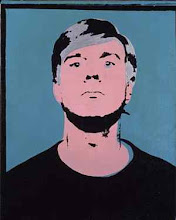Day 4 in Berlin was spent exploring some of the many art
galleries that have clustered around
Potsdamer Strasse. As Kimberly Bradley notes in Art Review many
of these are not conventional white cube spaces but occupy former apartments,
occasionally with grand, if faded, elegance; some are tucked away in courtyards
completely invisible from the street.
 |
| Entrance
hallway to Kunstsaele |
"For the
exhibition at Sommer & Kohl I wanted to formulate new sculptures that
would define the potential of the space rather sketchily, “poeticising space”.
I wanted to cast a glance into the future, with suggestions for new sculptures
and sketches for new projects. So I sat in my studio over the floor plan of the
gallery, drew my lines and a fabulous chaos emerged again, as usual..."
 |
| Knut
Henrik Henriksen, installation view |
 |
Knut Henrik Henriksen, Bird in Space (Erling
Viksø), 2014
|
|
 |
| Knut
Henrik Henriksen, Cumulus, 2015 |
 |
| Knut
Henrik Henriksen, Dead Centre, 2015 |
In the 'office'
space there was also an impressive painting by another of the gallery's artist,
Andreas Eriksson.
 |
| Andreas Eriksson, Untitled, 2013 |
%2C%2B1984%2B%40%2BKunstsaele.jpg) |
| Dieter Krieg - o. T. (Fischkopf), 1984 |
 |
| Dieter Krieg, installation view |
 |
Axel Loytved, th
Ab, 2014 (Found paper, black mdf, screws)
|
"Reproductions
of original cabinet card portraits of unknown women taken at the turn of the
19th century. The photographs show women from different geographical locations
including Austria, Bulgaria, China, Czechoslovakia, Germany, Italy, Korea,
Malaysia, the Netherlands, Thailand, Turkey and the USA."
 |
| Majla
Zeneli, Untitled, 2014 (Collage of mezzotint) |
 |
| Majla
Zeneli, Under the Glass, 2010 (Mezzotint) |
 |
| Majla
Zeneli, Television, 2011 (Mezzotint) |
 |
| Falk
Messerschmidt, Panel II, 2014 |
 |
| Kyra
Tabea Balderer, Untitled, 2013 |
 |
| Claus
Georg Stabe, Monstrance, 2014 |
And finally, the
best two shows of all:
"Ulrich
Wüst was one of the most important photographers of the GDR. But beyond that,
his work should be seen in a larger historical and international context of
photographers like Albert Renger-Patzsch, August Sander, Bernd und Hilla Becher
in Germany as well as Walker Evans and Stephen Shore in the US…
"A cool
observer of his time with a contentious relationship to social and political
contradictions, Wüst shoots his photographs in Berlin, Magdeburg, and Cologne –
three cities heavily marked by the destruction of the Second World War. His
analytic, purist photographs of urban space, city structures, and architecture
narrate and comment upon a significant chapter of German history in the throes of
massive change."
"Bucharest
city model (fragment), 1 to 330 in scale, is a cardboard architectural model.
Its placement at the entrance of the exhibition space forces visitors to step
on it in order to access the other exhibited works. The level of destruction of
the model is left up to the public, who are forced to choose their position of
either brutally damaging, or gently passing over this “obstacle”. The decision
to select Bucharest as a model does not only relate to the burden of demolition
that affected the city in communist times, but also to its present reality,
which is marked by urban chaos, recent random urban development, the
destruction of architectural heritage, and a tendency of its inhabitants to
create their own paths and micro-structures in their everyday life throughout
the city."
 |
| Ciprian
Muresan, 'Suicide Series', 2014, Arshile Gorky - The Artist and
his Mother 1926-42. (Coloured pencils on paper) |
 |
| Ciprian
Muresan, 'Suicide Series', 2014, Mark Rothko - No.12, 1951. (Coloured pencils on paper) |
 |
| Ciprian
Muresan, 'Suicide Series', 2014, Diane Arbus - The King and Queen of a Senior Citizens' Dance, NYC, 1970. (Coloured pencils on paper) |
"The
Suicide Series comprises a number of drawings executed in coloured pencil,
based on reproductions of works by artists who committed suicide. In the
artist’s words, the study relates to: “The danger of delving too deeply into
other people’s biographies, the tendency to want to speculate on the motives of
this final act, or the feeling of a certain kind of admiration for the courage
or recklessness of the action; perhaps equivalent to a fascination for the
morbid. [...] Here […] a tension is being created, in which you can be wrongly
tempted to read the works from the perspective of suicide as opposed to
considering their formal and aesthetic concerns. As the initial idea to borrow
original works by the cited artists can prove rather difficult these days, I
chose instead to continue my endeavours via art reproduction. The method that
inspired me is the colour printing technique that splits images into four
colour channels – CMYK. In order to copy the works as accurately as possible, I
reproduced the printing process and drew each colour channel successively, in
pencil.”
A second visit
to the Gemäldegalerie completed the day. (See Postcard 3, below)
See also
Postcards 1 and 2.







%2C%2B1984%2B%40%2BKunstsaele.jpg)












.jpg)










No comments:
Post a Comment